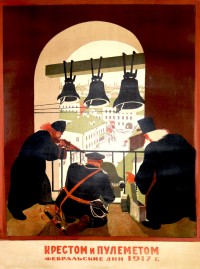AKhR
// АХР // Ассоциация художников революции // Assotsiatsiia khudozhnikov revolutsii // Association of Artists of the Revolution;
// АХРР // Ассоциация художников революционной россии // Assotsiatsiia khudozhnikov revolutsii rossii / Association of Artists of Revolutionary Russia
Association of Artists of the Revolution (AKhR) was founded in 1922 as an independent arts organization. It was later named the Association of Artists of Revolutionary Russia (AKhRR). The arts organization was, "committed to 'the life of the Red Army', the workers, the peasants, the revolutionaries, the heroes of labor". Its early years were characterized by a generally independent voice, free from influences within the Communist Party or from state-mandated artistic policies. In the mid-1920s, AKhRR developed its own publishing and printing sectors and had its own bureaus of exhibition. The organization's structure was so unique that no other artistic association in the USSR had such far-reaching and influential pull. While AKhRR obtained funding from Narkompros (People's Commissariat for Education) and it also received backing from Kliment Voroshilov, head of the Red Army. By the late 1920s, AKhRR artists began to split from within over disputes between young, proletarian-influenced artists who sought a new direction in mural art and propaganda agitation and older members who favored classical, epic-like genres. Due to this split in membership, artists once loyal to the Association moved on to form separate groups and AKhRR membership diminished. The late 1920s was also a period when the Communist Party of the Soviet Union forged ahead with the creation of a formal artistic policy known as Socialist Realism. AKhRR's fate was sealed once Socialist Realism was enacted as national policy and, the Association closed in 1932. Its remaining members and leadership went on to create the Union of Soviet Artists, (Soyuz Sovetskikh Khudozhnikov, SSKh) that same year.
![PP 1119: Red Front [Partial translation]](https://www.posterplakat.com/thumbs/the-collection/posters/pp-1119/pp-1119-catalog-image-200x287.jpg)
![PP 1129: The growth of agriculture in the USSR over ten years
[Partial translation]](https://www.posterplakat.com/thumbs/the-collection/posters/pp-1129/pp-1129-catalog-image-200x155.jpg)
